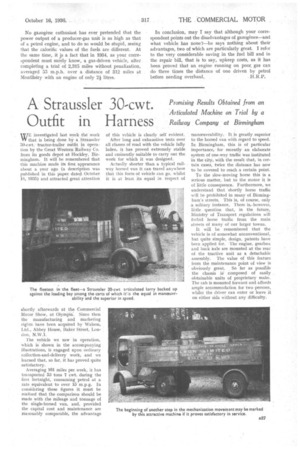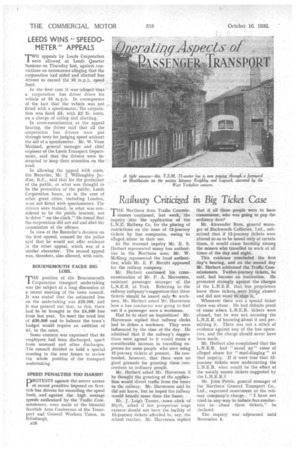Straussler 30-cwt.
Page 65

Page 66

If you've noticed an error in this article please click here to report it so we can fix it.
Outfit in Harness
Promising Results Obtained from an Articulated Machine on Trial by a Railway Company at Birmingham
WE investigated last week .the work ri that is being done by a..Straussler 30-cwt.tractor-trailer outfit in operation by the Great Western Railway Co. from its goods depot at Hockley, Birmingham. It will be remembered that this machine made its first 'appearance about a year ago (a description was published in this Paper: dated October 15, 1035) and attracted great attention shortly afterwards at the Commercial Motor Show, at OlymPias. Since then the manufacturing and marketing rights have been acquired by Walson, Ltd„ Abbey House, Baker Street, London, N.W.1.
The vehicle we saw in operation, which is shown in the accompanying illustrations, is engaged upon ordinary collection-and-delivery work, and we learned that, so far, it has proved quite satisfactory.
Averaging 161 miles per week, it has transported 58. -tons 7 cwt. during the first fortnight, consuming petrol at a rate equivalent to over 15. m.p.g. In considering • these figures it must. be realized that the comparison should be made with the mileage and tonnage of the single-horsed van, and, provided the capital cost and maintenance are reasonably comparable, the advantage of this vehicle is clearly, self evident.
After long and exhaustive tests over all classes of road with the vehicle fully laden, it has proved extremely stable and eminently suitable to carry out the work for which it was designed.
Actually shorter than a typical railway horsed van it can travel anywhere that this fornnof vehicle can go, whilst it is at least its equal in respect of manceuvrability. It is greatly .superior to the horsed van with.regard to speed. In Birmingham, this is of particular importance, for recently an elaborate system of one-way traffic Was instituted in the city, with the result that, in certain cases, twice the distance has now to be covered to reach a certain point.
To the slow-moving horse this is a serious matter, but to the motor it is of little consequence. Furthermore, We understand that -shortly horse traffic will be prohibited in many of Birmingham's streets. This is, of course, only a solitary instance. There is,however, little question that, in the future, Ministry of Transport regulations will forbid horse traffic from the main streets of many of our larger towns.
It will be remembered that the vehicle is of somewhat unconventional, but quite simple, design, patents have been applied for. .The engine, gearbox and back axle are inounted at the rear of the tractive unit as a detachable assembly. The value of this feature from the maintenance point of view is obviously great. So far as possible the chassis is composed of easily obtainable units of proprietary make. The cab is mounted forward and affords ample accommodation for two-persons, whilst the driver can enter or leave it on either side without any difficulty.
LEEDS WINS SPEEDOMETER " APPEALS
TWO appeals by Leeds s ....orporation 1 were allowed at Leeds Quarter Sessions on Thursday last, against convictions on summonses. alleging that the corporation had aided and abetted pus drivers to exceed the 30 m.p.h. speed limit.
In the first case it avas^allegedathat a corporation bus driver drove his vehicle at 93 m.p.h. In consequence of the fact that the vehicle was not fitted with a speedometer, the corporation was fined £5, with £2. 2s. costs. on a charge of aiding and abetting.
In cross-examination at the appeal hearing, the driver said that all the corporation bus drivers were put through tests for judging speed without the aid of a speedometer. Mr. W. Vane Morland, general manager and chief engineer of the Leeds Transport Departmerit, said that the drivers were instructed to keep their attention, on the road.
In allowing the appeal with costs, the Recorder, Mr. J. Willoughby Jacdine, K.C., said that for the protection of the public, or what was thought to be the protection of' the public, Leeds Corporation buses, as in the case of otheigreat cities, including London, were not fitted with speedometers. The drivers' were trained, in what was con-. sidered to be the public interest, not to drive ".on the dock." He found that the corporation did not aid and abet -the commission of the offence.
In view of the Recorder's decision on the first appeal, counsel for the police said that be would not offer evidence in the other appeal, which was of a• similar character. The second appeal was therefore, also allowed, with costs.
BOURNEMOUTH FACES BIG LOSS.
THE positionof the Bournemouth Corporation transport undertaking was the subject of a long discussion at a recent meeting of the town council. It was stated that the estimated loss on the undertaking was £26,000,' and it was pointed out. that, to this, there had to be brought in the £4,500 loss from last year. To. meet the total loss of €30,5.00 and to balance the town's budget would require an addition of 4d. to the rates.
Some concern was expressed that 84 employees, had been discharged, apart from seasonal and other discharges. The council decided to hold a special meeting in the near future toreview the whole position of the transport undertaking,
SPEED PENALTIES TOO HARSH?
PROTESTS against the severe nature of recent penalties imposed on Scottish bus 'drivers for exceeding the speed limit, and against the high average speeds authorized by the Traffic Commissioners, were made at the biennial Scottish Area Conference of the Transport and General. Workers Union, in Edinburgh.
B28








































































































